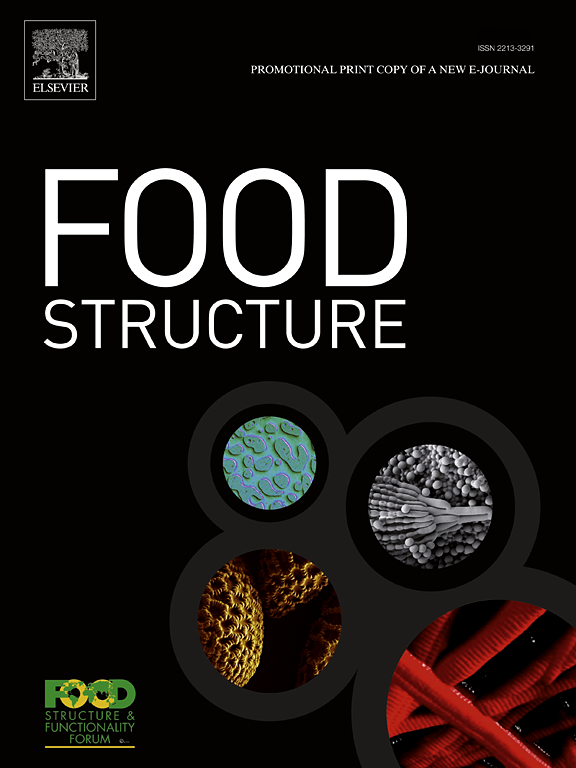Impact of hydrocolloids on 3D meat analog printing and cooking
IF 5.9
3区 农林科学
Q1 FOOD SCIENCE & TECHNOLOGY
引用次数: 0
Abstract
This study investigated the effects of hydrocolloid addition on three-dimensional (3D) printing and cooking of plant ingredients-based meat analog (MA). The MA inks were formulated with soy protein isolate, wheat gluten, canola oil, water, and hydrocolloids (xanthan gum, pectin, hydroxypropyl methylcellulose, guar gum, locust bean gum) at a ratio of 22:12:15:88:2. Formulated inks were used to create a specific 3D cylindrical model geometry and the printed structure were subjected to air frying (AF:180°C, 15 min) and infrared heating (IR:180°C, 15 min). Results showed that the MA ink’s viscosity (3871–5482 Pa. s), 3D printing rate (0.34–0.39 g.sec−1), printing error (2.51–10.37 %), and printing precision (81.97–97.27 %) were significantly (p<0.05) impacted by the incorporation of hydrocolloids. The dimensional stability (63.17–98.58 %), and cooking loss (6.70–17.41 %) were greatly impacted by both the hydrocolloids and post-printing cooking methods. Moisture (1.71 db) and fat (0.28 db) content of uncooked 3D printed MA were identical, whereas, differences in color attributes (L value:80.21–98.88, a value:0.01–0.13, b value:0.11–2.11) among the studied hydrocolloid added samples were observed. Moisture, fat, and color traits of 3D printed meat-analogs were significantly (p<0.05) impacted by post-printing cooking methods (AF, IR). During post-printing cooking, the loss of mass (moisture, fat) and changes in color tones were associated with the types of hydrocolloids incorporated in formulating the 3D printing ink. Surfaces and internal structure, mass loss, chemical profile, and glass-transition-temperature of 3D printed meat-analogs were significantly (p<0.05) impacted by both the type of incorporated hydrocolloids and post-printing cooking methods.
水胶体对 3D 肉类模拟打印和烹饪的影响
本研究调查了添加亲水胶体对基于植物成分的肉类模拟物(MA)的三维(3D)打印和烹饪的影响。肉类模拟油墨由大豆分离蛋白、小麦面筋、菜籽油、水和水胶体(黄原胶、果胶、羟丙基甲基纤维素、瓜尔豆胶、槐豆胶)按 22:12:15:88:2 的比例配制而成。配制好的油墨用于创建特定几何形状的三维圆柱模型,并对打印结构进行空气油炸(AF:180°C,15 分钟)和红外加热(IR:180°C,15 分钟)。结果表明,加入水胶体后,MA 油墨的粘度(3871-5482 Pa. s)、三维打印速率(0.34-0.39 g.sec-1)、打印误差(2.51-10.37 %)和打印精度(81.97-97.27 %)均受到显著影响(p<0.05)。水胶体和印刷后蒸煮方法对尺寸稳定性(63.17-98.58 %)和蒸煮损失(6.70-17.41 %)都有很大影响。未蒸煮的 3D 打印 MA 的水分(1.71 db)和脂肪(0.28 db)含量相同,而所研究的添加了水胶体的样品在颜色属性(L 值:80.21-98.88,a 值:0.01-0.13,b 值:0.11-2.11)方面存在差异。3D打印肉类样品的水分、脂肪和颜色特征受到打印后烹饪方法(AF、IR)的显著影响(p<0.05)。在打印后烹饪过程中,质量(水分、脂肪)的损失和色调的变化与 3D 打印油墨配方中加入的水胶体类型有关。3D打印肉类样品的表面和内部结构、质量损失、化学特征和玻璃化转变温度均受到所加入的水胶体类型和打印后烹饪方法的显著影响(p<0.05)。
本文章由计算机程序翻译,如有差异,请以英文原文为准。
求助全文
约1分钟内获得全文
求助全文
来源期刊

Food Structure-Netherlands
Chemical Engineering-Bioengineering
CiteScore
7.20
自引率
0.00%
发文量
48
期刊介绍:
Food Structure is the premier international forum devoted to the publication of high-quality original research on food structure. The focus of this journal is on food structure in the context of its relationship with molecular composition, processing and macroscopic properties (e.g., shelf stability, sensory properties, etc.). Manuscripts that only report qualitative findings and micrographs and that lack sound hypothesis-driven, quantitative structure-function research are not accepted. Significance of the research findings for the food science community and/or industry must also be highlighted.
 求助内容:
求助内容: 应助结果提醒方式:
应助结果提醒方式:


